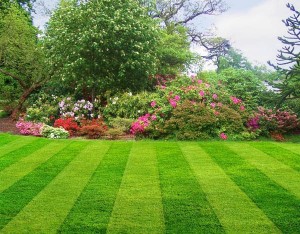
Lawns, a major part of the American tradition. If you look into the history of lawns, you will see that the traditional lawn has not been around that long. America has really started to take real pride in maintaining a beautifully landscaped yard. If you really want to put a perspective on landscaping, you could consider your lawn as the backdrop or canvas of your property. Everything stems from your lawn. Your house is an extension of your lawn. Your trees, shrubs, bushes, and flowers are all extensions too.
Now with that in mind, you must have a good background to bring out all the embellishments that have been added to your background. Walk around your yard and really look at your lawn. Are there some dead spots, thin spots, discolored spots?
If you do notice any of these types of issues you should go through the process of elimination to find out if your lawn is infected with some kind of insect, worms or fungus. You might also want to have your soil tested to make sure all the proper mineral contents are within the best-recommended specifications. This can save you a lot of time in the long run if one of the above is the issue. You can re-seed or re-sod the bad spots but they will just die off again, so to save a lot of hassle it is recommended that you do a thorough investigation of the perceived problem.
Some of the determining factors that will help you figure out if your lawn needs a tune-up are:
- Approximately 40% to 50% of your lawn is dead.
- When walking across the lawn if feels soft and spongy.
- Your lawn getting taken over by weeds.
There are many determining factors, but these three are the major factors. Sometimes just making simple modifications to basic lawn care practices or improving site conditions is all you need to revive your lawn.
So if you have determined that your lawn needs a little pick me up or a little bit more, the best time to re-seed is in late summer between August 15th to September 20th. The next best time would be in April or May. Re-sodding can be done pretty much year round with proper soil prep. Late summer is the preferred time for re-seeding for the following reasons:
- The soil is warmer which is better for germination.
- There are fewer problems with weeds.
- The cooler season encourages grass growth.
- There is less chance of water evaporation as this process requires a lot of water.
If you are planning to do just some small patch repair (8’ or less) it is recommended that you use 1 part seed with 4 parts of natural organic fertilizer. This way you can accomplish two tasks at the same time. Try working up the soil just a little bit to give the lawn seed just a little more to adhere to. The seeds are very, very light and will blow away easily. You can also use straw or fine netting available at your local home improvement store. After you have spread the grass seed another recommendation is pressing the seed into the ground, just a light pressing will do. You can use just any tool you can think of to press the seeds down. You can also install a very thin layer of topsoil over it to help keep the birds from eating all of it!
Then comes the hardest part. The daily watering and then getting down on your hands and knees looking for the little green sprouts. Depending on the type of grass you decided on planting, germination can take anywhere from 5-28 days. You should do your best to keep the soil moist at all times, this keeps the germination time to a minimum.
When you have finished this tedious process, the payoff will be worth the work and effort. Remember this is the backdrop for everything on your property. You want it to look the best it can. Once all this is completed the lawn is ready for your enjoyment and the neighbors will be in awe! Until next time…Happy Gardening!!
Jimmie